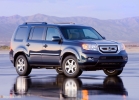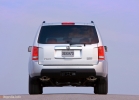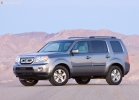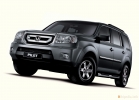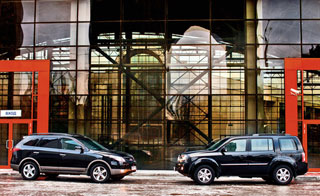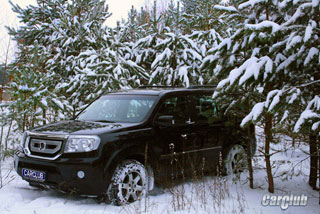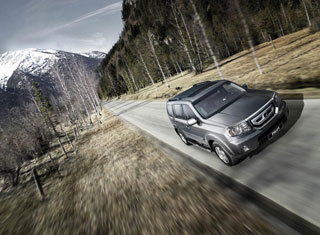Honda Pilot test drive since 2009 SUV
Review of the Honda Pilot SUV before the premiere in the Russian market
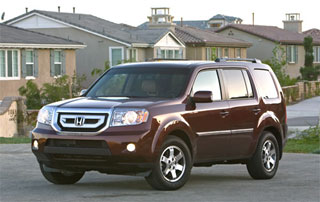 This year Honda will begin sales of a new second -generation Honda Pilot SUV in the Russian market. To date, the Russian prices for this car are even known, but the novelty has not yet entered the salons of official dealers. We bring to your attention a test drive of the American version of the Honda Pilot SUV in the maximum configuration of Touring.
This year Honda will begin sales of a new second -generation Honda Pilot SUV in the Russian market. To date, the Russian prices for this car are even known, but the novelty has not yet entered the salons of official dealers. We bring to your attention a test drive of the American version of the Honda Pilot SUV in the maximum configuration of Touring. If the new Honda Pilot is trying to prove something, then only one in the Honda concern has changed a lot. Only the crazy design of the radiator lattice suggests that the company is unforgivably deepened in the desire to decorate the vehicles. The overall impression of the car: it is a little less angular than Jeep Commander; There are so many folds and bends on the back that it resembles an origami figure weighing 2 tons.
Although masculine, rude, in the spirit of abstract expressionism, but origami. And all because this full -size crossover is trying to show that he is a real SUV, which is quite capable of delivering you to the forest camp, to carry a trailer with your motorcycle, a lover of outdoor activities that are not afraid of snow and ice, despite his family character.
The first -generation Pilot looked like a reduced copy of the 1968 Travellar model of the American company International Harvester. The new version looks ready for the main role in the futuristic remake of the film Green Soilent of 1973. And, nevertheless, under the guise of a macho, a simple and reliable Honda is hidden, exactly what it should be.
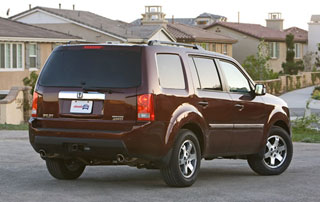 More, more, even more
More, more, even more A capable of placing eight people on three rows of seats, initially Pilot was a rather large car. And, despite this, the second generation of Honda Pilot is even more, in all respects.
And the total length of the body and the length of the wheelbase increased by 7.3 cm in comparison with the first generation. This lengthening was reflected, in particular, in access to the third row of seats it became easier: it was worth only moving forward the second row and, bending a little, a woman of 76 years old without much difficulty sat down, which was very not bad. And the seats on the third row, due to the increase in the car in length and height, have become larger. Of course, even now the third row can not be called spacious, but due to an additional place for the legs of passengers, as much as 4.8 cm, adults of small height can ride there and feel quite comfortable.
A longer wheelbase made it possible to add spaces for the legs of passengers of the second row (another 2.7 cm) and open the rear doors more widely. For a car of this size, landing and landing are extremely comfortable.
If you fold all the seats (the second and third rows in the ratio of 40/60), then Pilot will have 2.46 cubic meters. meters to place luggage. And when all seats are raised, then 0.58 cubic meters remain for baggage. meters, which is quite enough to take 4 packages with products from a supermarket for our younger children (this is enough for this for an hour and a half). There is also a hidden luggage space under the floor covering in the luggage compartment: they would prefer to hide the curious neighbors from the eyes of the eyes, buying something exclusively for themselves.
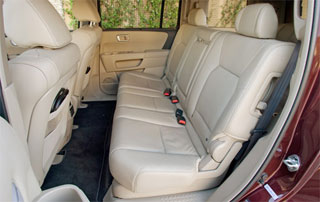 So, the new Pilot has become more. But at least Honda managed to use this increase in essence and in places where it is necessary.
So, the new Pilot has become more. But at least Honda managed to use this increase in essence and in places where it is necessary. Similar mechanical equipment
Inside the new Honda Pilot wrapper you will find somewhat updated options for previous devices.
The structure is still a solid monoblock, sharpened under small congresses from asphalt tracks (the base is the same as that of Honda Odyssey and her brother, Acura MDX). The suspension still consists of depreciation racks of the McPherson type in front and an independent multi -link system behind. And the transverse engine already familiar to us by the V6 unit from the Honda with a volume of 3.5 liters. The only proposed transmission is a variation of the previous five -speed automatic gearbox, which was present on first -generation cars, it is also installed in modern Odyssey minivans.
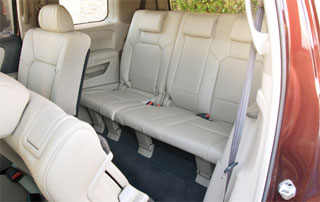 The all-wheel drive system is still represented by the development of Honda Variable Torque Management Four Wheel Drive (VTM-4) smart, compact system for transmitting torque to the rear wheels based on the indications of numerous sensors controlled by the computer. True, there is no reduced gear. The front -wheel drive is offered as a standard one, and it should be noted more than enough if the car is used for shopping trips, and not for the assault on unusual forests.
The all-wheel drive system is still represented by the development of Honda Variable Torque Management Four Wheel Drive (VTM-4) smart, compact system for transmitting torque to the rear wheels based on the indications of numerous sensors controlled by the computer. True, there is no reduced gear. The front -wheel drive is offered as a standard one, and it should be noted more than enough if the car is used for shopping trips, and not for the assault on unusual forests. The suspension course, in comparison with the first generation, must be admitted. Of course, the 6-cylinder engine SOHC, equipped with a VTEC gas distribution phase system now produces 250 hp. Instead of the previous 244. There is also a Honda Variable Cylinder Management (VCM) system, which closes the fuel supply of half the cylinders if the engine does not carry a large load, which can significantly save fuel. Wheel disks increased from 16 to 17 inches, respectively, the size of the tires increased. Nevertheless, these changes are not particularly stunning. As there is nothing stunning in the behavior of a car on the road.
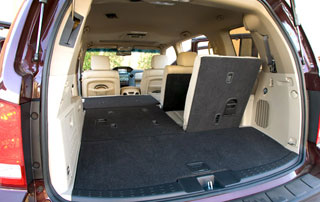 We went here earlier
We went here earlier Track tests showed the following results: Honda Pilot in the top -end set Touring accelerates from 0 to 100 km/h for 9.7 s, and 402 meters passes in 17.2 s at a speed of 130.8 km/h at the finish line. Switching the transmission is very vigorous, it is impossible not to notice them, and they hint that in the presence of the sixth speed of acceleration, they would be more intense with lower gear rates. But with everyday use, the transmission is very friendly.
Unfortunately, the increase in size could not help but the growth of Pilot mass. The Honda argues that the Pilot LX basic equipment with the front wheel drives 1,612 kg, which is as much as 20.5 kg more than the 2008 model. But our scales gave out other results: Pilot Touring in the most complete configuration with a 4x4 drive weighs as much as 1,720 kg. This weight is limit, which can withstand Michelin LTX M/S 245/65 R17 tires.
Pilot turned out to be prone to skidding when slalom passes, but steering is quite agile to catch the ass of the car, so that the Pilot speed is 95.6 km/h on slalom, which is quite acceptable for its class (as well as lateral acceleration of 0.76G). When braking, however, the Pilot pecked with his nose and braking distance from 100 km/h to stop the full stopped 45.42 m. There was also a decrease in the efficiency of the brakes, for each subsequent stop it took more and more time, the pedal became increasingly sluggish, and the front brakes The pads exuded a less pleasant aroma. Maybe more sports tires focused on aggressive street riding would minimize these shortcomings, and Honda may have to take a whole squadron of brake systems in order to configure the ABS system for normal operation.
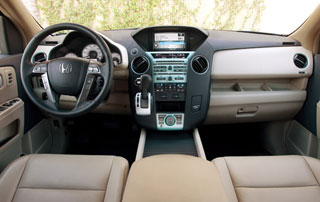 Riot on board
Riot on board The seats of the new Honda Pilot are the most convenient of all that we came across on new cars a beautiful shape, high -quality tightening with good skin and easy tuning for any driver. But the front panel is the most unsuccessful of all that Honda has ever installed.
Start counting how many materials were used when decorating the panel, and your fingers on your hands will end very quickly. In the center is a fragment of blue plastic, illuminated from the inside, which looks like a kitchen panel from IKEA, and there is also black plastic, gray plastic, vanilla plastic and white devices. This cacophony of forms and different decoration styles tires the more, the longer you are inside. Fortunately, the basic equipment of the LX or more expensive is not so much affected by the flight of designers' fantasy as the Touring equipment, although even they are more stylized than an extremely (and pleasant) calm panel in the first generation Pilot.
To our joy, in Honda, they have not lost the ability to place all switches and regulators logically clear, and the quality of the decoration of materials (regardless of what color they are) is at a very high level. There is a lot of places for storing things necessary in the trip, including the collapsible central console, where it seems that you can fit a whole supermarket. Like the previous Pilot, and most Honda models in general, this machine has an extremely practical interior, which will also last you for many years. It is a pity that the design is somewhat crazy.
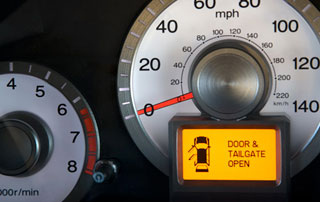 The readings of the devices are quite good and simply read, despite the fact that the light background of the devices somewhat interferes with the rapid perception of data in bright sunlight. The green light bulb lights up every time when the computer gives the command half to close the cylinders, as if Pilot could not be patient to boast of his care for the state of the environment. But in fact, this is just an idiotic bulb that greatly irritates the driver. The light should light up when something is wrong, otherwise it is superfluous.
The readings of the devices are quite good and simply read, despite the fact that the light background of the devices somewhat interferes with the rapid perception of data in bright sunlight. The green light bulb lights up every time when the computer gives the command half to close the cylinders, as if Pilot could not be patient to boast of his care for the state of the environment. But in fact, this is just an idiotic bulb that greatly irritates the driver. The light should light up when something is wrong, otherwise it is superfluous. Powerful computer
Now that the GPS systems are in ordinary cell phones, the question arose: is it profitable in principle to install satellite navigation on any machine. But, nevertheless, Honda equipped the new Pilot with an impressive filling with an impressive filling.
The sound of the stereo system is magnificent, because it is represented by a cd changer, a satellite radio receiver of HM, an additional entrance and a USB port with the ability to connect the iPod (even the iPhone works with the Honda audio system is surprisingly sweet). And the navigation system, despite its bulky and unusual, works easily and intuitively clear. The DVD player for passengers has a successful design and is conveniently placed, even provided that the children now watch the video using PSP and other devices (cheaper) pocket format.
This is a good on -board entertainment system. Although, most likely, it will become morally out of the next three years.
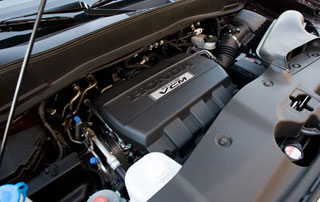 Honda has acquired a reputation as a company that creates economical cars with an attractive design. But the new Pilot is in that it is the only Honda model, the fuel hunting. According to the measurements of the ERA, the Pilot model consumption with all -wheel drive is 14.7 liters per 100 km when moving around the city and 10.7 along the highway, which is a little better than that of the 2008 Pilot, and mainly thanks to the VCM system. And such appetite is quite enough for people who do not particularly need 8 seats in the car prefer Honda CR-V.
Honda has acquired a reputation as a company that creates economical cars with an attractive design. But the new Pilot is in that it is the only Honda model, the fuel hunting. According to the measurements of the ERA, the Pilot model consumption with all -wheel drive is 14.7 liters per 100 km when moving around the city and 10.7 along the highway, which is a little better than that of the 2008 Pilot, and mainly thanks to the VCM system. And such appetite is quite enough for people who do not particularly need 8 seats in the car prefer Honda CR-V. Honda Pilot has all the possibilities present at first -generation machines, and adds a little more space to them for everyone. He rides well, does not make noise, the engine work is smooth and quite decent to those limits that are allotted to him. The new exterior design did not make a proper impression on us, but at least it does not conflict with the exceptional practicality of this massive SUV.
Our assessment is as follows: most buyers will prefer more modest LX and EX configuration for long -term use than Touring equipment. In addition, not being burdened with numerous ridiculous cunning devices, simpler Pilot configurations are deprived of many complex electronic devices, some of which are outdated in a year or two. But at the same time, the proposed level perfectly provides easy handling, and their cost is more acceptable than that of the tested version for $ 40,665.
Honda, again, should be easier.
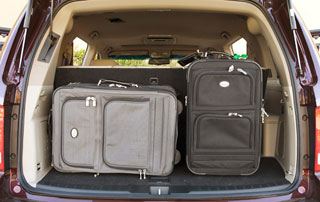
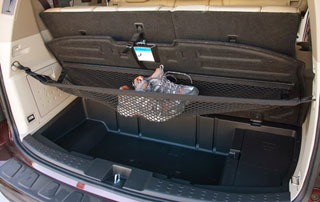
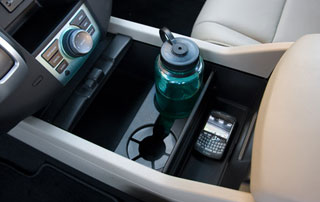
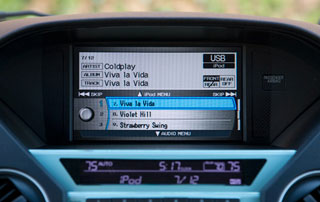
Source: Insideline

